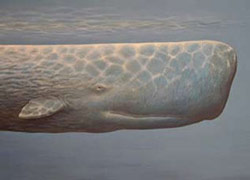- Sperm whale family
Taxobox
name = Sperm whales
fossil_range =Oligocene to Recent

image_caption =Sperm Whale , "Physeter macrocephalus"
image_width = 250px
regnum =Animal ia
phylum = Chordata
classis =Mammal ia
ordo =Cetacea
subordo =Odontoceti
subdivision_ranks = Families and genera
subdivision = Kogiidae Gill, 1871 "Kogia " Physeteridae Gray, 1821 "Physeter "The sperm whale family or simply the sperm whales is the collective name given to three species of
whale found worldwide; theSperm Whale , in the genus "Physeter", and thePygmy Sperm Whale andDwarf Sperm Whale , in the genus "Kogia". In the past these genera have sometimes been united in the single family, Physeteridae, with the two "Kogia" species in a subfamily (Kogiinae), however recent practice is to allocate the genus "Kogia" to its own family, Kogiidae, leaving Physeteridae as a monotypic (single extant species) family, although additional fossil representatives of both families are known (see "Evolution"). The name Sperm Whale comes from sailors of whaling boats who thought that thespermaceti on the whales head was actualsperm from the reproductive system.Characteristics
The Sperm Whale is the largest species of toothed whale, with adult bulls(males) growing to be about 15-18 metres (50-60 feet) long, and weighing about 45-70 tonnes. The two kogiid species are much smaller, at only around 2.5 to 3.5 metres (9-11 feet) in length, and weighing 350-500 kilograms (770-1,100 pounds).
The body of sperm whales is robustly proportioned, with paddled-shaped flippers. The lower jaw is always relatively small and thin relative to the upper jaw. The
nasal bone s of sperm whales are distinctly asymmetrical, with the blowhole being located on the left side of the head; in the Sperm Whale this is near the top of the head, while on the kogiids it is further forward. All species have a large number of similar, and relatively simple, teeth. In the kogiids, and sometimes also in the Sperm Whale, the teeth in the upper jaw do not erupt, and are sometimes altogether absent.cite book |editor=Macdonald, D.|author= Lockyer, Christina|year=1984 |title= The Encyclopedia of Mammals|publisher= Facts on File|location=New York|pages= 204-209|isbn= 0-87196-871-1]The eyes of sperm whales are unable to swivel in their sockets, and possess only a vestigial
anterior chamber . It is likely thatecholocation is a far more important sense to these animals than vision.Another common characteristic is the
spermaceti , a semi-liquid waxy white substance filling the 'case' or spermaceti organ in the whale's head, which plays the role of a ballast in diving and maintaining buoyancy. This is done by flushing cold water though the nose, hardening the spermaceti, to dive, and pumping warm blood to melt the spermaceti to surface. (See the individual species articles for further details). All three species dive to great depths to find food, although the Sperm Whale is believed to dive much deeper than either of the kogiids. Members of both families eat squid, fish, and even sharks.Gestation lasts from nine to fifteen months, depending on species. The single calf remains with the mother for at least two years, before being weaned. Sperm whales do not reach full sexual maturity for several years. All species congregate together in 'pods' or herds, consisting of mostly females, calfs, and adolescent males, although these pod sizes are typically smaller in the kogiids.Evolution
The earliest sperm whale fossils are known from the late
Oligocene - about 25 million years ago [Stucky, R. E. & McKenna, M. C. (1993). Mammalia. Pp. 739-771 in Benton, M. J. ed.: The Fossil Record 2. Chapman & Hall, London.] , Mchedlidze. G. A. (2002). Sperm whales, evolution. Pp. 1172-1174 in Perrin, W. F., Würsic, B. & Thewissen, J. G. M. eds.: "Encyclopedia of Marine Mammals". Academic Press, San Diego.] , with an ancestry tracing back from the latestEocene before diverging from the remainder of the Odontocetid line, leading to thedolphin s, andporpoise s.The
fossil record suggests that sperm whales were more common in theMiocene , where basal lineages (such as "Zygophyseter " and "Naganocetus ") existed; other fossil genera assigned to the Physeteridae include "Ferecetotherium ", "Helvicetus ", "Idiorophus ", "Diaphorocetus ", "Aulophyseter ", "Orycterocetus ", "Scaldicetus ", and "Placoziphius ", while Kogiid fossil genera include "Kogiopsis ", "Scaphokogia ", and "Praekogia ". The earliest kogiids are known from the lateMiocene , around 7 million years ago [Perrin, W. F., Würsic, B. & Thewissen, J. G. M. eds.: "Encyclopedia of Marine Mammals". Academic Press, San Diego, 1414 pp.] .The close relationship between extant Physeteridae and Kogiidae is confirmed in recent molecular studies using mitochondrial cytochrome "b" [Verma, S. K., Sinha, R. K. & Singh, L. (2004). Phylogenetic position of "Platanista gangetica": insights from the mitochondrial cytochrome b and nuclear interphotoreceptor retinoid-binding protein gene sequences. "Molecular Phylogenetics and Evolution" 33: 280-288.] , [May-Collado, L. & Agnarsson, I. (2006). Cytochrome "b" and Bayesian inference of whale phylogeny. "Molecular Phylogenetics and Evolution" 38: 344-354] ; on the basis of these analyses, their nearest relatives appear to be the
Ziphiidae on one hand, and theMysticeti andPlatanistidae on the other. The last cited paper also favours the grouping of Physeteridae and Kogiidae in a single superfamily, Physeteroidea, as has sometimes previously been suggested. Bianucci & Landini, 2006 [Bianucci, G. & Landini, W. 2006. Killer sperm whale: a new basal physeteroid (Mammalia, Cetacea) from the Late Miocene of Italy. "Zoological Journal of the Linnean Society" 148: 103–131.] suggest that "Diaphorocetus ", "Zygophyseter ", "Naganocetus " and "Aulophyseter " pre-date the inferred split of Kogiidae and Physeteridae and thus would restrict the family Physeteridae to those genera that post-date this split (acladistic view).Classification
*ORDER: CETACEA
**Suborder:Mysticeti
**Suborder:Odontoceti
***Superfamily: Platanistoidea
***Family: Delphinidae
***Family: Phocoenidae
***Family:Monodontidae
***Family: Ziphiidae
***unranked: Physeteroidea
****"Diaphorocetus" (extinct)
****"Zygophyseter" (extinct)
****"Brygmophyseter" (= "Naganocetus")(extinct)
****"Aulophyseter" (extinct)
****Family: Physteridae
*****Sperm Whale "Physeter catodon" (syn. "P. macrocephalus")
*****"Orycterocetus" (extinct)
*****"Placoziphius" (extinct)
*****"Idiophyseter" (extinct)
*****"Physeterula" (extinct)
****Family: Kogiidae
*****Pygmy Sperm Whale "Kogia breviceps"
*****Dwarf Sperm Whale "Kogia simus"
*****"Scaphokogia" (extinct)References
Wikimedia Foundation. 2010.
